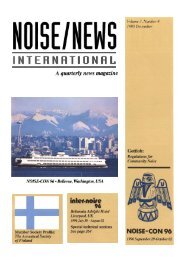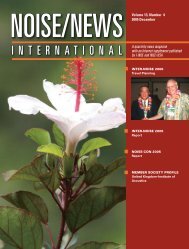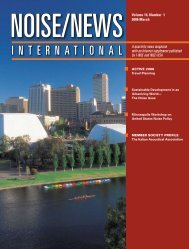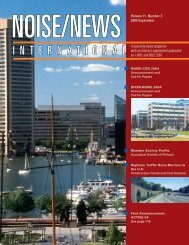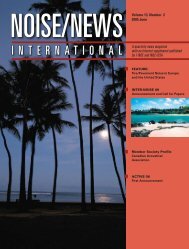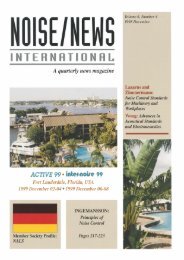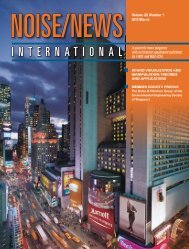Volume 15, Number 4, December, 2007 - Noise News International
Volume 15, Number 4, December, 2007 - Noise News International
Volume 15, Number 4, December, 2007 - Noise News International
- No tags were found...
Create successful ePaper yourself
Turn your PDF publications into a flip-book with our unique Google optimized e-Paper software.
A: That’s a good point. I’m from Houstonand Houston is hot. So the buildingsare air conditioned. If you were toput sound masking in its place, peoplewould stand underneath it thinking itwas air conditioning. We’ve got to havethe AC noise to know that we’re cool.Some office cubicles might be 6 ft by8 ft with a partition as low as 5 ft or ashigh as 6 ft or 7 ft, and the backgroundnoise varies considerably. Some placesdon’t have any background noisemasking systems, and you learn to dealwith it. Others have masking systemsthat are in the 45 dBA range.C: (David Lubman) Consider an officethat uses background masking noise tosustain their use of open-plan offices.This is really a low-cost way of fillingan office so that the number of workersper square meter is largest and the costfor the owners is lowest. But even ifthey use the lowest level of maskingnoise that’s usually recommendedwhich is 45 dBA, the average speechlevel of office workers is 50 dBA.That means that at a distance of onemeter, the speech to noise ratio is only5 dB. Is that enough? The owners arepaying the price for this in reducedproductivity and might reconsider ifthey knew they were not saving asmuch money as they thought.OSHA and FRA RulemakingQ: Bob Bruce, what do you see as thebiggest barrier to getting OSHA to leadas opposed to follow?A: I don’t know, it’s a difficult problem.The Federal Railway Administration(FRA), in a unique moment in history,revised its rule. They put out a Noticeof Proposed Rule Making and manyresponded, including the NationalHearing Conservation Association anda number of individuals. Although therespondents advised 85 dBA with a 3dB exchange rate, the FRA decidedagainst it and documented the decisionwith over 130 pages of explanationsprinkled with names like Ted Schultzand Elliott Berger who urged them toadopt the 85/3 dB rule. My opinionis that they didn’t have the courage togo against OSHA directly. But, whileOSHA has an absolute cut-off of 1<strong>15</strong>dB for <strong>15</strong> minutes of exposure, inlocomotive cabs the rule permits up to120 dB but only for 5 seconds. It’s asif somebody said, “The horns will blowfor short intervals so we’d better get thatnumber up.” But FRA did do a numberof good things, e.g. they forced in airconditionedcabs. The railroads foryears said they could not air-conditioncabs. In the 1980s, the railroads saidit was impossible.But then a Canadianlocomotive was air-conditioned. Thatis amusing, but in the late 1930s therailway passenger cars had a new thingcalled air-conditioning. And one of thereasons they did it was to reduce thenoise inside the passenger car.Toward a Global Policy on <strong>Noise</strong>Q: To the panel. How can the differentcontributions of this workshop be usedto move toward a global policy on noise?What is the relationship between thisworkshop and a global policy on noise?A: (Bob Bruce) The one place wherewe’ve had progress is in the schoolsituation; we’ve taken a giant stepforward in making schools better.Perhaps we could figure out how toapply that to other areas. Nick Ashfordfrom MIT’s policy program said thatthe problem with noise is that the noiseinside factories does not get linked toanything that’s perceived as important.C: (Bill Lang) Where do we go fromhere? Our series of global noise policyworkshops has become more focusedon specific topics. Today we focusedon implementation and enforcement.We will focus on other areas in ourfuture workshops. We have to developan action plan, and that action planmust involve the NGOs because theyrepresent the public. If we don’thave the public, then we cannot putpressure on government authorities todo something about noise. The morethan forty I-INCE Member Societiesare part of the action because they areall NGOs, and we would expect them tobe founding members of a worldwideorganization of NGOs that are unitedin this effort. Then it must be movedinto an international advocacy positionto force something to happen at thetop. Whether it will take 5 years or fivedecades is impossible to predict.C: (Samir Gerges) This workshop isvery informative and provides a lotof information. But there are notmany people from South America,China, India, and some other countriesparticipating. And we need to involvelocal authorities. What we propose maylook good on paper; but if it’s a matterof local policy, it is important to involvepeople in those agencies to participate.C: (Bill Lang) But it is not just localpeople. There are national and internationalissues that must be addressed.C: (Samir Gerges) Yes, I can see that.In Asia the problem is much biggerbecause, for example, in Hong Kongthere are only about 300 square milesof area in which 7 million people live.In Sweden they have the luxury ofmore than 173,500 square miles with 9million people, and they can enjoy whatis unthinkable for those in Hong Kong.In Brazil we have a similar problem.Therefore, it would be interesting tohave other countries participate.C: (Bill Lang) Absolutely. When we getto the international advocacy stage, wemust have all countries of the worldrepresented. Today there are over 200members in the United Nations. Thiswould compose an international advocacygroup where all countries are representedand the cultural, geographical,and ethnical differences between themwould be taken into account.146 www.inceusa.org • www.noisenewsinternational.net • www.i-ince.org <strong>2007</strong> <strong>December</strong>



